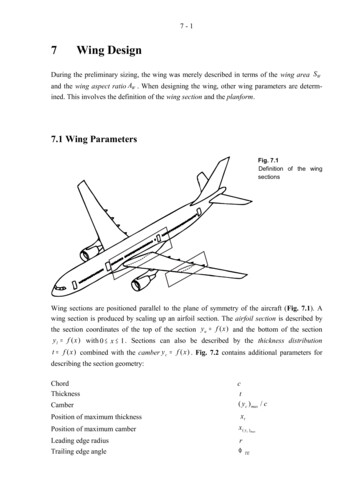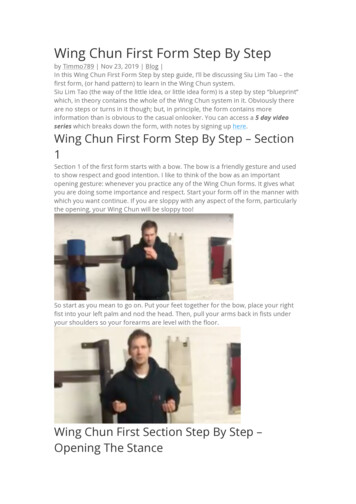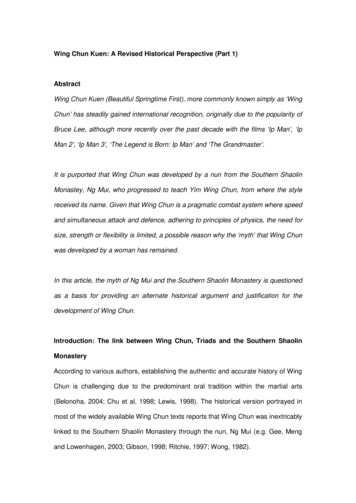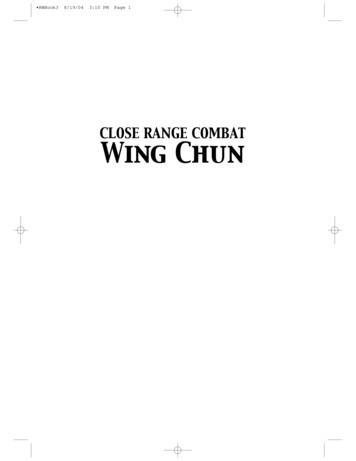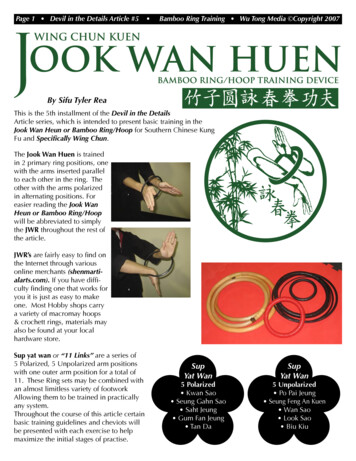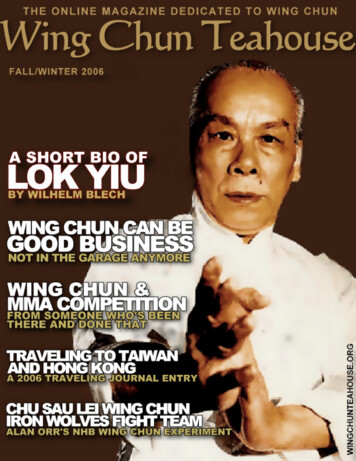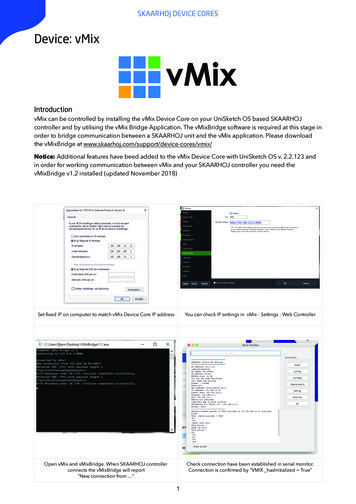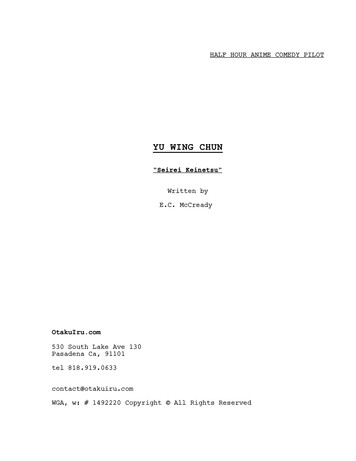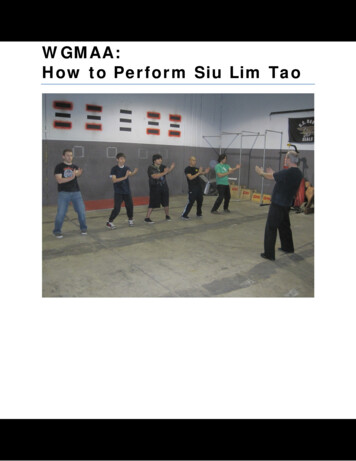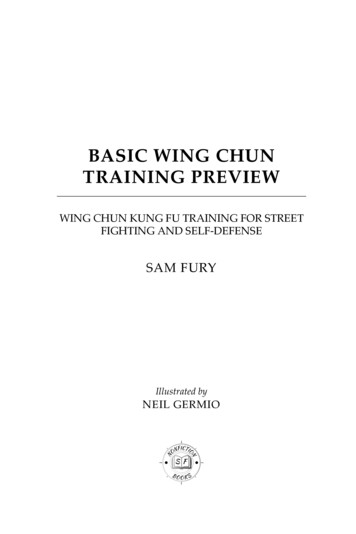
Transcription
BASIC WING CHUNTRAINING PREVIEWWING CHUN KUNG FU TRAINING FOR STREETFIGHTING AND SELF DEFENSESAM FURYIllustrated byDIANA MANGOBA
Copyright Sam Fury 2014www.SurvivalFitnessPlan.comAll Rights ReservedNo part of this document may be reproduced without written consent from the author.
WARNINGS AND DISCLAIMERSThe information in this publication is made public for referenceonly.Neither the author, publisher, nor anyone else involved in theproduction of this publication is responsible for how the reader usesthe information or the result of his/her actions.Consult a physician before undertaking any new form of physicalactivity.
CONTENTSIntroductionGetting the Most from This BookLesson 1 - The Half SquatLesson 2 – Fighting StanceLesson 3 – Basic FootworkLesson 4 – Single PunchLesson 5 – Triple PunchLesson 6 - Stepping PunchLesson 7 – Tan SauLesson 8 - Counter-AttackLesson 9 – GrabbingLesson 10 – Pak SauLesson 11 – Defending Against the Hook-Cross CombinationLesson 12 - Center-Line PrincipleLesson 13 – Bong SauLesson 14 - Lap Sau DrillLesson 15 – Forearm ConditioningLesson 16 – The ChopLesson 17 – Uppercut DefenseLesson 18 – Triple DefenseLesson 19 - Three KicksLesson 20 - Stepping Side Kick
viContentsLesson 21 – Punch RollLesson 22 – TrappingLesson 23 - Wrist Grab EscapeLesson 24 – Punch Roll Lap Sau InterchangeLesson 25 – Kau SauLesson 26 – Side Kick DefenseLesson 27 – Round Kick DefenseLesson 28 – Gum SauLesson 29 - Elbow DrillLesson 30 – Intercepting KicksLesson 31 - Low-Kick High-Kick DefenseLesson 32 – Punch Roll Elbow Drill InterchangeLesson 33 – Biu SauLesson 34 - Boxing DefenseLesson 35 - Punch Roll KicksLesson 36 – Leg GrabLesson 37 – Kick CountersLesson 38 – Chop DrillLesson 39 – Grab and AttackLesson 40 – Double GrabsLesson 41 - Tackle DefenseLesson 42 – SparringBonus Materials
ContentsAuthor RecommendationsSurvival Fitness Plan Training ManualsAbout the Authorvii
INTRODUCTIONI wrote this book as a training guide to progressively teach thoseinterested in Wing Chun the fundamental Wing Chun techniquesand concepts and how they can be applied to modern street-fightingscenarios.Although I feel anyone with an interest in marital arts will gainvalue from it is primarily intended for:People who are thinking about learning Wing Chun butfirst want an insight.People who want to learn Wing Chun but want some basicknowledge of principles and techniques before joining aclass.Beginners who are already learning Wing Chun and wantto supplement their training.Teachers of Wing Chun who want some ideas on trainingbeginner students.Anyone that wants to self-train in Wing Chun Kung Fu.In any case, whom-ever you are and for what-ever reason youpurchased this book, I sincerely hope that you get some valuefrom it.Sam Fury
GETTING THE MOST FROM THIS BOOKTo get the most out of this book the exercises should be repeatedand practiced regularly. Access to a training schedule is included atthe end which complies with this. It is recommended that youfollow it.Practice all exercises slowly to begin with. Get the technique rightand learn to understand the static movement first. Then build onspeed and power. Practice all exercises on both sides of your body.All the lessons in this book focus purely on the adaptation of WingChun. It is advised that you also have a physical fitness regime.www.SurvivalFitnessPlan.com covers physical fitness trainingin detail.One of the big differences between this and other Wing Chuntraining books is that this book shows how to adapt the Wing Chunlessons to the modern street fight. In a real fight you will not be upagainst another Wing Chun practitioner. It is important that yourtraining partner does not attack you like a Wing Chun fighter. Mostpeople will fight similar to a boxer/muay thai fighter, so many of theexercises are adapted to defending against common boxing/muaythai style attacks.In a real street fight you will probably not have the chance to getinto your Wing Chun stance, and even if you do it is advised not todo so. You do not want to let your opponent know what you aregoing to do. Instead, move freely and naturally, not rigid. Once youare in Wing Chun fighting range you can use the Wing Chun princi‐ples and techniques.Keep an open mind and adapt what you learn in a way that worksfor you. There are no restrictions and you don’t know how youropponent is going to react. The exercises are merely examples ofwhat could be done.In the same spirit as keeping an open mind, since this book adapts
2S A M F U RYWing Chun to modern street-fighting many of the exercisesincluded may not be considered traditional Wing Chun, or theymay be known by different names.When training, do things properly. Put feeling and movement intothe techniques. If you train sloppy and weak, then that is how it willbe applied in reality. If you do them properly it will instill correctmuscle memory so that in times of stress you will still be able toreact properly. You will hit your opponent correctly and apply pres‐sure in the right places. Your body will be of correct structure andplacement and you will instinctively know where he/she is.Although you train for reality, it is still training. There will be manytimes when practicing with your partner when you may think, “ButI can just hit him/her here” or “I could easily block that”. Thesethings may be true, and it is good to think of them, but you arelearning. Give each-other the time to learn. Understand the princi‐ples and do the exercises properly. During free sparring you canexpress yourself fully.Use training equipment. You want to be able to train hard but youdo not want to get injured. The only way to do this is to use propertraining equipment, e.g., pads and sparring equipment.Even when using training equipment you will still feel pain some‐times. It is good to be conditioned to pain. In a real fight you willfeel pain and the body reacts differently when it feels pain. It isuseful to be aware of it. Start soft and gradually increase force tobuild your pain tolerance.
LESSON 1 - THE HALF SQUATThis shoulder width half squat will help you build the leg musclesneeded for many of the following exercises.It is important to build strength in this way as it will help withbalance, footwork, stepping, turning and many other things.Stand straight with your feet together and your hands by your sides,then bend your knees slightly and turn your heels out.Plant your heels down and turn your toes out, then plant your toesand turn your heels out. Bring your hands in fists under your cheston either side of your torso.
4S A M F U RYRemember these five steps to get to this position. This will bereferred to as the half squat position and is the starting point forsome exercises.While in this position drop your knees down and then come backup. This is one squat.Your knees will never fully straighten.Exercise 1 – The Half SquatDo as many half squats as you can in a given time frame.
LESSON 2 – FIGHTING STANCEIn a real fight you will probably not adopt this exact fighting stancebut it is a good fundamental stance for correct application of tech‐niques when learning and is often referred to as a starting positionfor upcoming exercises.Lead and Rear SidesWhichever leg and hand is forward most is your lead. Whichever legand hand is to the back is your rear.In actual combat it is preferred that your strongest side is your leadbut you should always train on both sides.Adopting the Fighting StanceStart in the half squat. Whilst keeping your feet in the same spot,turn on them so that one leg is in front of the other.Put your hands up to around chest height. Whichever leg is forwardmost, the same hand is also forward most.Your rear leg supports most of your body’s weight, approximately70% of it. You should be able to easily lift your lead foot into the airif needed, e.g., for kicking. Keep your arms slightly bent.
6S A M F U RYSwitching SidesLearning the correct way to switch sides helps to build strength inthe legs, gets you familiar with how to turn your body and intro‐duces the correct use of weight distribution which helps withstability and increasing power in your strikes. Start in the fightingstance.Assuming you are in a left lead stance, rotate your body with yourfeet to the right. You will rotate 180 . As you do so your body weightshifts from your left leg to your right and your hands also changeposition. You finish in the fighting stance with a right lead.Exercise 2 – Switching SidesRepeat the switching sides exercise from left to right and vise-versa.
LESSON 20 - STEPPING SIDE KICKThe stepping side kick is useful for attacking low (knee level orbelow) while closing ground. It combines basic stepping with theside kick.Begin in your fighting stance.Step forward a couple of times.When ready, as your rear foot comes up plant it firmly into theground so you can do the side kick with your lead leg.Drop your foot back to the ground and then repeat the process.Do this a few times and then use switching sides to turn around soyou can do it using your other side.Here is the view from the front so you can see the line of the bodywith the hands.
8S A M F U RYExercise 41 – Stepping Side KickPractice the stepping side kick on both sides of your body. Stepforward two or three times and then kick.
LESSON 39 – GRAB AND ATTACKThis lesson focuses on deflecting a strike and grabbing your oppo‐nents striking arm in one motion whilst simultaneously attacking.You have to have good reflexes to do this. It is where all the drillspay off.Grab PunchThis lesson teaches the basic grabbing and punch movement as wellas the importance of maintaining distance.As your opponent throws a straight punch deflect it on the outsideof your arm and grab him/her by the lower arm. This is the sametype of grab as in exercise 40 (three kicks application) but now youwill go faster. As soon as you grab the arm step forward and pullyour opponent into your attack.Your attacking arm must be firm on his/her upper arm otherwisehe/she can elbow you.
10S A M F U RYIt is best to be cautious about your distance. If you are far away youcan always pull your opponent in, but if you are too close he/shecan hurt you.Move with your opponent to maintain correct distance. If youropponent forces you back, step back. If he/she steps back, stepforward.Exercise 82 – Grab PunchPractice the grab punch as a fluid movement.Grab Rib PunchThis shows the grab punch at a different target area, the ribs. Ittakes advantage of your opponent’s forward movement.As your opponent punches grab the arm and move in to punchhis/her ribs. The punch lands as your opponent moves in.
Basic Wing Chun Training Preview11Alternate sides as you do it.Ensure you hold your opponent’s hand up to protect your head. Beaware that he/she may drag it down. You want your opponent’sbody in line but his/her hand out of the way.
12S A M F U RYBe wary of your distance. If you are too far you cannot hit him/herand if too close your opponent will be able to bend his/her arm andelbow you.Exercise 83 – Grab Rib PunchPractice the grab rib punch in a fluid motion.Grab Stomp KickThis demonstrates the grab with the stomp kick and revisits theimportance of balance.As the punch comes in grab and kick your opponent in the knee (gofor the shin in training).It is important that you grab your opponent and are in controlbefore you kick otherwise it will be easy for him/her to upset yourbalance.Pull your opponent’s arm and push out your kick at the same time.If your leg is not strong enough your opponent can push you over.This is where the half squats pay off.
Basic Wing Chun Training Preview13Step back and do the same thing on the other side.Exercise 84 – Grab Stomp KickPractice the grab stomp kick exercise on both sides.Grab Side KickThis shows grabbing with the side kick and revisits the importanceof distance.As the punch comes in use Pak Sau and then grab his/her arm. Sidekick to the knee or just above it.
14S A M F U RYStep back and do the same on the other side.Your distance should be so that your opponent’s arm cannot reachyou. Even if you do not use your hands you should be okay.Have a slight forward lean. If you lean back your opponent canpush you over. Also, if you are leaning forward then even if youropponent steps back you maintain distance for attack.
Basic Wing Chun Training Preview 15 Never make your leg completely straight. If your leg is completelystraight and your opponent moves back even just a little you willmiss.If you aim for your leg to still be a little bent on landing then if youropponent steps back you can still get him/her. If your opponentdoesn’t step back then your strike will do more damage.Exercise 85 – Grab Side KickPractice the grab side kick on both sides.When moving naturally you have to be fast. Grab and attackstraight away otherwise your opponent won’t be there.Double Side KickThis shows how to repeat the side kick. It is important to understandwhere the two of your bodies are and where to place your leg.As the punch comes in grab the arm and side kick your opponent tohis/her mid-section.Bring your foot back down to the ground and then kick him/heragain.
16S A M F U RYExercise 86 – Double Side KickPractice the double side kick.The kicks do not need to go to the mid-section or even to the sametarget, e.g., you could kick low to your opponent’s knee first andthen higher into his/her mid-section.Grab and ElbowThis lesson demonstrates using the elbow with the grab. Elbows cando a lot of damage but you need to be inside your opponent’s guardand up close which results in a greater risk of you being hit.Defect your opponent’s punch and grab his/her arm. Bring yourelbow up so it is parallel to the ground.
Basic Wing Chun Training Preview17Step forward and drive your elbow into your opponent’s chest orhead. It is best to keep the strike around the same height as yourshoulder, i.e., if your opponent is too tall don’t aim for his/her head.The movement is fluid and fast.Exercise 87 – Grab and ElbowPractice the grab and elbow.As a variation, when you bring your elbow up angle it so your elbowis higher than your hand.Crash down onto your target. Do not lean forward. Step in so yourwhole body creates the power while you stay balanced and incontrol.
18S A M F U RYExercise 88 – Grab and Elbow VariationPractice this variation of the grab and elbow.Grab and KneeThis shows how to use the grab with the knee. Like elbows, kneescan do a lot of damage but you need to be inside your opponent’sguard and close resulting in a greater risk of you being hit.As your opponent strikes deflect and grab his/her arm on the elbowwith both hands. You must control the elbow or you are at risk ofgetting hit in the face.Put a knee into his/her thigh, groin (not in training) or higher if youwant.Do not use a big movement. Make it small and sharp.
Basic Wing Chun Training Preview19Exercise 89 – Grab and KneePractice the grab and knee.Exercise 90 – Grab and CounterHave your partner throw straight attacks as you. Grab and counterin any way you wish.
Dear Reader,Thank you for reading the Basic Wing Chun Training Preview.If you would like to purchase the full book please TrainingThanks again for your support,Sam Fury, Author.
SURVIVAL FITNESS PLAN TRAINING MANUALSSurvival FitnessWhen in danger, you have two options: fight or flight.This series contains training manuals on the best methods of flight.Together with self-defense, you can train in them for general healthand fitness.Parkour. All the parkour skills you need to overcomeobstacles in your path.Climbing. Focusing on essential bouldering techniques.Riding. Essential mountain-bike riding techniques. Go asfast as possible in the safest manner.Swimming. Swimming for endurance and/or speed usingthe most efficient strokes.It also has books covering general health and wellness, such as yogaand tness-SeriesSelf-DefenseThe Self-Defense Series has volumes on some of the martial artsused as a base in SFP self-defense.It also contains the SFP self-defense training manuals. SFP SelfDefense is an efficient and effective form of minimalist nse-SeriesEscape, Evasion, and SurvivalSFP escape, evasion, and survival skills (EES) focus on minimalism.They are EES using little to no special equipment.
22S A M F U RYDisaster Survival. How to prepare for and react in thecase of disaster and/or societal collapse.Escape and Evasion. The ability to escape capture andhide from your enemy.Urban and Wilderness Survival. Being able to live offthe land in all terrains.Emergency Roping. Basic climbing skills and improvisedroping techniques.Water Rescue. Life-saving water skills based on surf lifesaving and military training course competencies.Wilderness First Aid. Modern medicine for use inemergency situations.Sustainable Living. Creating a lifestyle with minimalimpact on the environment and maximum self-reliance.Financial Freedom. Long-term survival in the moderneconomic-based urvival-Series
ABOUT THE AUTHORSam Fury has had a passion forsurvival, evasion, resistance, andescape (SERE) training since he wasa young boy growing up in Australia.This led him to years of training andcareer experience in related subjects,including martial arts, military train‐ing, and outdoor pursuits.These days, he spends his timerefining his skills and sharing what he learns via his books and valFitnessPlantwitter.com/Survival /samfury
interested in Wing Chun the fundamental Wing Chun techniques and concepts and how they can be applied to modern street-fighting scenarios. Although I feel anyone with an interest in marital arts will gain value from it is primarily intended for: People who are thinking about learning Wing Chun but first want an insight.

